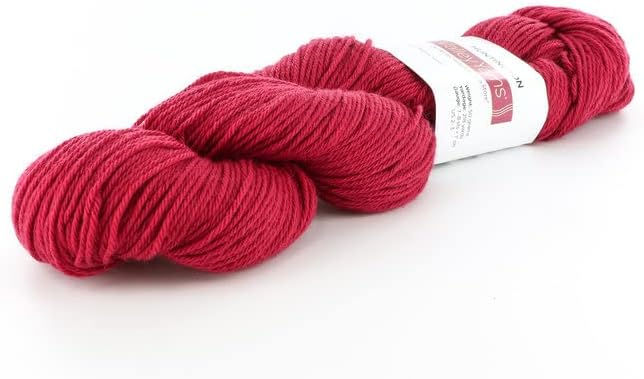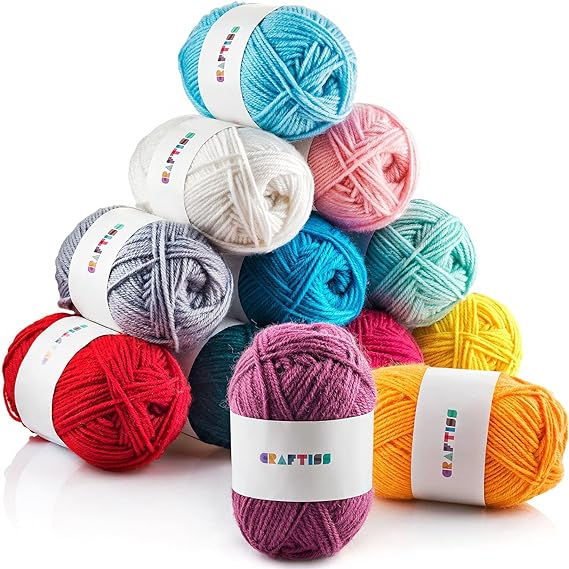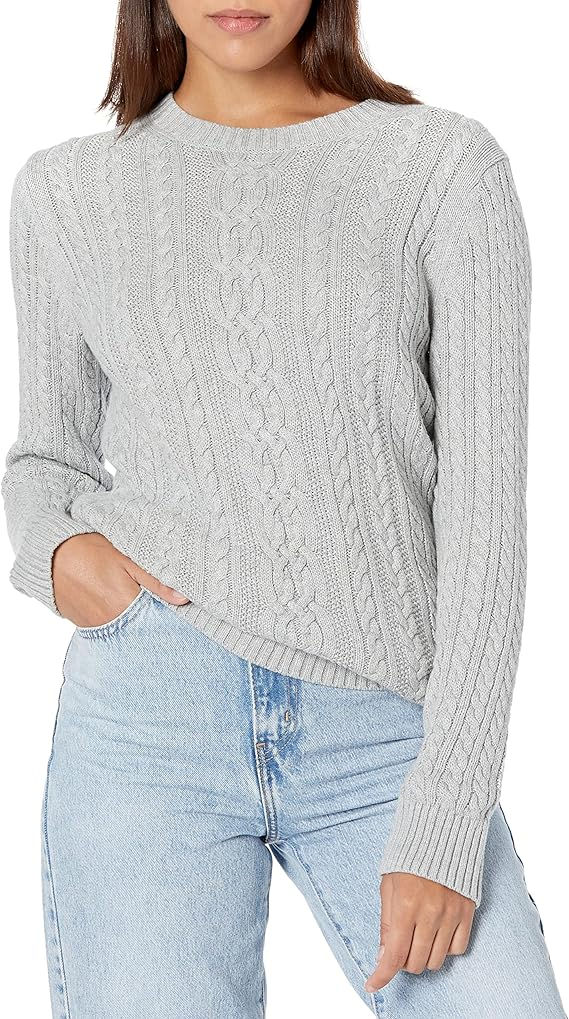Yarn Weight 101: Your Essential Guide
- Silly Monkey Knits
- Jan 12, 2024
- 7 min read
In the vibrant universe of knitting and crocheting, where creativity knows no bounds, there's an often underestimated factor that can significantly impact the outcome of your projects - yarn weight. It's not just a technicality; it's a key that unlocks a realm of possibilities for crafters. So, let's dive into the intricacies of yarn weight and explore how it shapes your crafting experience. Imagine your project as a canvas, and yarn weight as the brushstroke that defines its texture, drape, and overall aesthetic. Yarn weight is essentially the thickness of the yarn strand, and it plays a crucial role in determining the final look and feel of your creation.

Standard Yarn Weight System:
In the vast and colorful universe of yarn, where textures and hues intertwine to create masterpieces, a standardized system of categorizing yarn weights acts as a guiding star for crafters. This system not only simplifies the selection process but also opens up a world of creative possibilities.
Delicate Intricacies of Lace: Picture the fine threads of lace weight yarn, akin to a whisper in the crafting realm. This weight, marked by its delicate nature, is perfect for projects that demand ethereal beauty. Shawls with intricate lace patterns and delicate doilies come to life with the gentle touch of lace weight yarn. In the standardized yarn weight system, lace weight sits at the feather-light end of the spectrum.
2. Versatile Fingering Weight: Moving along the spectrum, we encounter fingering weight yarn. This versatile category strikes a balance between delicacy and substance. Ideal for lightweight garments and detailed socks, fingering weight yarn allows crafters to create intricate stitch patterns while maintaining a graceful drape. It stands as a go-to choice for projects that demand both subtlety and detail.
3. Worsted Weight: The Middle Ground: Enter worsted weight, the heart of the yarn weight spectrum. Offering a delightful balance of thickness and pliability, worsted weight yarn is a staple for various projects. From cozy sweaters to stylish accessories, this category accommodates a broad range of crafting endeavors. Understanding the numbering system associated with worsted weight empowers crafters to grasp its medium thickness, making it a versatile choice for both beginners and seasoned artisans.
4. Bulky and Super Bulky: Crafting Bold Statements: As we venture into the thicker realms of yarn, we encounter bulky and super bulky weights. Bulky yarn, with its substantial thickness, adds a touch of coziness to winter wearables and home décor. It provides a swift and satisfying crafting experience. Moving further along the spectrum, super bulky yarn makes a bold statement, creating projects that are not only quick to complete but also wonderfully plush and warm.
Understanding the Numbering System:
Now, let's unravel the mystery behind the numbers associated with each yarn weight. The numbering system associated with yarn weights is a standardized classification that provides a quick and universally understood reference for the thickness or thickness range of a particular yarn. Yarns are assigned numerical values to denote their weight categories, and these numbers typically appear on yarn labels. The higher the number, the thicker the yarn.
Here's a general overview of the numerical values associated with common yarn weight categories:
Lace Weight (0 or 1): This is the lightest yarn category, ideal for delicate and lacy projects.
Fingering Weight (1 or 2): Slightly thicker than lace weight, fingering weight yarn is versatile and often used for lightweight garments and accessories.
Sport Weight (2 or 3): A medium-weight yarn suitable for a range of projects, including garments and accessories.
Worsted Weight (4): A popular choice for a variety of projects, worsted weight yarn is medium-thick and works well for both beginners and experienced crafters.
Bulky Weight (5): This yarn is thicker and is often chosen for projects that require a quicker finish, such as warm winter wear.
Super Bulky Weight (6): The thickest yarn category, super bulky yarn is used for projects that need to be completed rapidly and often result in plush, chunky textures.

The numbering system is designed to help crafters easily identify and choose yarns based on their desired thickness for a particular project. It serves as a shared language within the crafting community, enabling effective communication and pattern interpretation. Understanding this numbering system empowers crafters to make informed decisions when selecting yarn for their creative endeavors.
Comparisons and Substitutions: Navigating Yarn Weight Waters
Crafters, in their creative journeys, often stumble upon a gorgeous pattern only to discover that the yarn weight specified isn't readily available in their stash. It's a moment of hesitation, but fear not! This is where the art of substituting yarn weights comes into play, and it's more than just a workaround—it's an opportunity to infuse your project with a personal touch.
Understanding Yarn Weight Compatibility: Every yarn weight has its unique characteristics, affecting the drape, texture, and overall appearance of the finished piece. When substituting yarn weights, it's crucial to consider these factors. While the pattern might call for a delicate lace weight for a shawl, you might find that a slightly thicker fingering weight yarn can create a similar effect with a different visual and tactile appeal.
Importance of Achieving the Right Gauge: Gauge, the number of stitches and rows per inch, is a critical element in any knitting or crochet project. When substituting yarn weights, achieving the right gauge becomes even more vital. The pattern's recommended gauge ensures that the finished dimensions match the design's intent. If your yarn weight differs, adjusting your tension or even needle/hook size may be necessary to maintain the project's proportions.


3. Flexibility and Uniqueness: The beauty of substituting yarn weights lies in the flexibility it provides. It allows you to adapt projects to your preferences and the materials you have on hand. Maybe you're drawn to the texture of a worsted weight yarn for a pattern that suggests a sport weight—this subtle shift can transform the entire look and feel of the project, making it uniquely yours.
Tips for Successful Substitutions:
Check Pattern Recommendations: Some patterns provide guidance on suitable yarn substitutions. Look for notes on acceptable yarn weight ranges and suggested adjustments.
Consider Fiber Content: Different fibers can behave differently, even within the same weight category. Pay attention to the fiber content of your chosen substitute to ensure it aligns with the project's requirements.
Make a Gauge Swatch: Before diving into your project, create a gauge swatch using the substituted yarn. This not only helps you adjust your tension but also gives you a preview of how the final piece will look and feel.
Embrace Experimentation: Don't be afraid to experiment. Substituting yarn weights opens the door to unexpected discoveries and allows you to put your personal stamp on the project.
Selecting Yarn for Projects: Understanding the Nuances
Choosing the right yarn for your project involves more than simply following a pattern's suggested yarn weight. It's a nuanced decision that can significantly impact the overall look and feel of your creation. Here's a closer look at the factors to consider:
Garment Drape: Different yarn weights contribute to varying degrees of drape in finished garments. Lighter weights like lace or fingering yarns create a delicate, airy drape, perfect for shawls and summer garments. Heavier weights such as worsted or bulky yarns offer more structure, suitable for cozy sweaters and winter accessories.
Warmth: Yarn weight plays a crucial role in determining the warmth of your finished project. Bulky and super bulky yarns produce thick, warm fabrics ideal for winter wear, while lighter weights like lace and fingering are better suited for breathable, lightweight pieces.
Stitch Definition: The thickness of the yarn impacts stitch definition. Finer yarns showcase intricate stitch patterns more clearly, making them ideal for detailed lacework or cable designs. On the other hand, thicker yarns may offer a more textured and bold appearance, suitable for simpler stitch patterns.
Navigating these considerations allows you to tailor your yarn choice to the specific needs of your project, ensuring the final result aligns with your vision.
Yarn Weight Labels: Decoding the Language of Yarn Labels
Deciphering yarn labels is an essential skill for every crafter. These labels provide a wealth of information, and understanding them empowers you to make informed choices for your projects.

Here's a breakdown of key components:
Weight Category: Yarn labels often indicate the weight category using a numerical system. Whether it's lace, fingering, worsted, or bulky, this information guides you in selecting a yarn suitable for your intended project.
Fiber Content: Know the materials you're working with. The label specifies the fiber content, whether it's wool, cotton, acrylic, or a blend. Understanding fiber properties helps you anticipate how the yarn will behave in your project.
Recommended Needle or Hook Size: The label typically suggests a range of needle or hook sizes that work well with the yarn. Adhering to these recommendations enhances the chances of achieving the desired gauge and drape for your project.

There is some additional information given in the above square box (see above picture). To achieve the correct gauge for your project, create a 4-inch by 4-inch swatch using the specified needles and yarn. For this swatch, cast on 16 stitches and work up to 22 rows. This serves as a reference to ensure your stitch and row count align with the intended measurements. For instance, if you plan to make an 8-inch scarf, double the cast-on stitches from the 4-inch swatch. Therefore, you would cast on 32 stitches for the 8-inch width. This method helps you maintain the proper gauge for accurate sizing in your knitting project. Same way you will follow for crochet too.
4. Other Important Details: Labels may include care instructions, yardage, and dye lot information. These details contribute to the overall success and longevity of your project.
Yarn Weight and Skill Level: Crafting Within Your Comfort Zone
Aligning yarn weight with your skill level is an art that can enhance your crafting experience. Here's a closer look at this relationship:
Simplifying with Lighter Weights: If you're a beginner or looking for a relaxing project, starting with lighter weight yarns like lace or fingering can simplify the process. The smaller stitches allow for a slower pace and easier troubleshooting.
Challenging with Heavier Weights: On the flip side, choosing heavier yarns such as worsted or bulky can introduce challenges and excitement for more advanced crafters. The quicker progress and larger stitches can add a dynamic element to your projects.
Balancing your skill level with the chosen yarn weight ensures that you embark on projects that not only inspire but also match your proficiency, creating a satisfying and enjoyable crafting experience
As you embark on future projects, may the knowledge gained here empower you to confidently navigate the yarn-filled realms. Happy crafting, fellow artisans, and may your yarn endeavors be rich with creativity and fulfillment. The next chapter of your crafting tale awaits, ready to be woven with the vibrant threads of newfound expertise.
In the spirit of community and shared knowledge, we invite you to share your yarn weight-related challenges and curiosities. This interactive exchange will create a dynamic space for learning and problem-solving within our crafting community.

























Comments